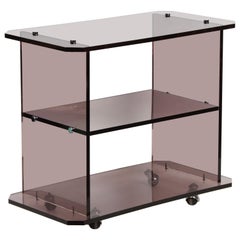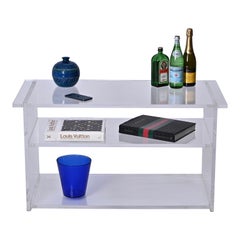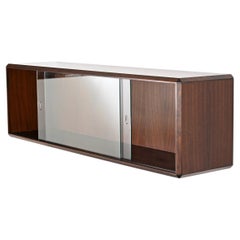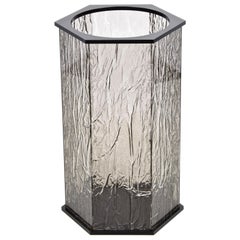Want more images or videos?
Request additional images or videos from the seller
1 of 21
Steel Wood and Smoked Glass Italian Showcase Attributed to Willy Rizzo 1980s
$4,308.73List Price
About the Item
- Attributed to:Willy Rizzo (Designer)
- Dimensions:Height: 70.08 in (178 cm)Width: 29.53 in (75 cm)Depth: 13.39 in (34 cm)
- Style:Mid-Century Modern (Of the Period)
- Materials and Techniques:
- Place of Origin:
- Period:
- Date of Manufacture:1980s
- Condition:Wear consistent with age and use.
- Seller Location:Roma, IT
- Reference Number:1stDibs: LU3067321988122
About the Seller
5.0
Platinum Seller
Premium sellers with a 4.7+ rating and 24-hour response times
Established in 1990
1stDibs seller since 2017
1,764 sales on 1stDibs
Typical response time: 1 hour
Authenticity Guarantee
In the unlikely event there’s an issue with an item’s authenticity, contact us within 1 year for a full refund. DetailsMoney-Back Guarantee
If your item is not as described, is damaged in transit, or does not arrive, contact us within 7 days for a full refund. Details24-Hour Cancellation
You have a 24-hour grace period in which to reconsider your purchase, with no questions asked.Vetted Professional Sellers
Our world-class sellers must adhere to strict standards for service and quality, maintaining the integrity of our listings.Price-Match Guarantee
If you find that a seller listed the same item for a lower price elsewhere, we’ll match it.Trusted Global Delivery
Our best-in-class carrier network provides specialized shipping options worldwide, including custom delivery.You May Also Like
Willy Rizzo Smoked Glass Cabinet for Mario Sabot, 1970
By Willy Rizzo, Mario Sabot
Located in Voorburg, NL
Beautiful Smoked glass cabinet designed by Willy Rizzo for Mario Sabot, 1970s. The cabinet comes with smoked glass with accenting brass hardware. The frame of the cabinet is made of ...
Category
Mid-20th Century Belgian Mid-Century Modern Cabinets
Materials
Brass, Steel
Willy Rizzo Sequoia Burl and Black Lacquer Display Cabinet with Glass Doors 1970
By Willy Rizzo
Located in Almelo, NL
Willy Rizzo Sequoia Burl and Black Lacquer Display Cabinet with Glass Doors, 1970s
Elegant, bold, and timeless—this rare Sequoia Burl Display Cabinet, designed by Willy Rizzo for Ma...
Category
Vintage 1970s Italian Mid-Century Modern Vitrines
Materials
Burl
$7,730
H 74.81 in W 51.97 in D 20.48 in
Cart attributed to Willy Rizzo
By Romeo Rega, Mario Sabot, Alain Delon, Maison Jansen, Willy Rizzo
Located in Lugo, IT
Cart attributed to Willy Rizzo.
The lower part of the glass corner is broken.
The upper part is a little broken as shown in the photo
Good condition.
Thanks
Category
Vintage 1970s Italian Modern Dry Bars
Materials
Brass, Steel
De Coene Showcase in Glass, Steel and Teak
By De Coene Frères
Located in Waalwijk, NL
De Coene, showcase, teak, steel, glass, Belgium, 1960s
Modernist showcase with lockable doors, accompanied with a steel frame and wooden shelf. The vitrine features the Brutalist characteristics of De Coene. The showcase was originally designed for a governmental building in Brussels. The Kunstwerkstede De Coene was invited to design the interior project in the late 1950s-1960s. De Coene designed several high-quality pieces exclusively for this building, among others these vitrines. For the design of these pieces, De Coene was inspired by the previous furniture in this building, which were designed by master designer Jules Wabbes. This is reflected for example in the steel frame.
De Coene was founded in 1887 in Kortrijk (Belgium) by Jozef de Coene, who was at that time 13 years old. In 1895, his younger brother Adolphe joined the company. In their early years, De Coene was inspired by Henry van de Velde, Art Deco and the Arts & Crafts movement. The company made many custom made furnishings which leads to an expansive growth. After world war one, the brother visited the United States where they became acquainted with laminated wood production, and purchased a wood-stripping machine. They were the first company that made triplex in Belgium which led to the ability to mass produce. In 1954 they received the right to produce Knoll furniture. But although the company produced on a large-scale, their were still world famous for their meticulously detailed, high-quality and Art Deco inspired furniture.
Category
Vintage 1960s Belgian Mid-Century Modern Vitrines
Materials
Steel
De Coene Showcases in Glass, Steel and Teak
By De Coene Frères
Located in Waalwijk, NL
De Coene, showcases, teak, steel, glass, Belgium, 1960s
Modernist showcases with lockable doors, accompanied with a steel frame and wooden shelf. The vitrines feature the Brutalist...
Category
Vintage 1960s Belgian Mid-Century Modern Vitrines
Materials
Steel
Sequoia Burl Bar Cabinet by Willy Rizzo for Mario Sabot
By Willy Rizzo, Mario Sabot
Located in Conversano, IT
Elegant, bold, and timeless: this rare bar cabinet designed by Willy Rizzo is the perfect embodiment of his unmistakable style, suspended between rationalist functionalism and sophis...
Category
Vintage 1970s Italian Hollywood Regency Vitrines
Materials
Brass, Chrome
Italian Mid-Century Modern Wood and Glass Showcase Display Cabinet Storage Case
Located in Miami, FL
Six feet tall and four-level glass shelves Mid-Century Modern showcase made in Italy.
Wooden base and tall glass and chrome column display or storag...
Category
Late 20th Century Italian Mid-Century Modern Vitrines
Materials
Chrome
$2,200
H 72 in W 27.5 in D 14.5 in
Vintage 1990s Italian walnut wood showcase
By Mice di rugiano domenico e c. s.n.c.
Located in Cantù, IT
Vintage 1990s Italian walnut wood showcase
Category
20th Century Italian Louis XVI Vitrines
Materials
Wood
1940s Blonde Wood with Glass Collectors Showcase
Located in Ferndale, MI
Blonde wood framed cabinet with mirror back interior thick lipped edge shelves. Sides and top are glass with two sliding glass doors . One door is original one door is eighth inch gl...
Category
Mid-20th Century American Mid-Century Modern Vitrines
Materials
Glass, Maple
Antique Glass, Bronze and Steel Jewelry Showcase or Vitrine
By Maison Jansen
Located in New York, NY
A beautiful antique French gilt bronze, patinated bronze, steel and glass jewelry vitrine or showcase, Paris, circa 1890-1910. It is very unusual to see these vitrines having the ori...
Category
20th Century French Louis XVI Vitrines
Materials
Bronze
More From This Seller
View AllMidcentury Italian Smoked Lucite Service Trolley, Willy Rizzo Style, 1980s
By Willy Rizzo
Located in Roma, IT
Elegant midcentury service trolley in smoked plexiglass. This magnificent item is in the style of Willy Rizzo and was produced in Italy during the 1980s.
This piece is unique beca...
Category
Vintage 1980s Italian Mid-Century Modern Carts and Bar Carts
Materials
Acrylic, Lucite, Plexiglass
Clear Lucite Three Tier Coffee Table, Showcase or Bookcase, Italy 1980s
By Charles Hollis Jones
Located in Roma, IT
Fantastic Showcase or coffee table fully made in clear lucite. This gorgeous piece was produced in Italy in the 1980s, clearly in the style of Charles Hollis Jones.
This versatile ...
Category
Mid-20th Century Italian Mid-Century Modern Coffee and Cocktail Tables
Materials
Acrylic, Lucite, Plexiglass
Dino Cavalli Italian Showcase or Wall Shelf, Wood and Sliding Glass, Italy 1970s
By Dino Cavalli
Located in Roma, IT
Marvellous Italian showcase in wood with sliding crystal glasses. This elegant and versatile object was designed by Dino Cavalli in Italy during the 1970s.
The quality of the wood ...
Category
Mid-20th Century Italian Mid-Century Modern Vitrines
Materials
Crystal
Midcentury Hexagonal Ice Lucite Italian Umbrella Stands after Willy Rizzo, 1980s
By Willy Rizzo
Located in Roma, IT
Midcentury hexagonal umbrella stands in ice and black Lucite. This stunning item was produced after Willy Rizzo, 1980s
This piece has beautiful yet simple lines, with a clear inspiration from Willy Rizzo's design. The Lucite is designed in order to produce a "freezing" ice effect.
An incredible object that will enrich a mid-century entrance hall or corridor.
Dimensions (cm):
Width - 32
Depth - 28
Height - 52
Italian designer and photographer Willy Rizzo (1928-2013) first came to prominence in the 1960s as both a chronicler of and participant in La Dolce Vita, the glamorous, jet set lifestyle enjoyed by many international celebrities and socialites in the postwar era. While photography was Rizzo's first love, in the 1970s he developed a passion for interiors and launched a second successful career as a luxury furniture designer.
Rizzo was born in Naples in 1928 but moved to France at an early age. After expressing an interest in photography at the age of 12, Rizzo's mother gifted him an Agfa Box camera; soon he was shooting portraits of his classmates at Paris's Istituto Statale Italiano Leonardo Da Vinci.
In the 1940s, Rizzo began his career as a photojournalist, working for several French publications, including Ciné Mondial, Point de Vue, and Image du Monde. In the aftermath of the Second World War, Rizzo notably covered the Nuremberg Trials and traveled to Tunisia for Point de Vue to photograph the conflict in North Africa, which was later published in Life Magazine. As his reputation grew, he was hired by France Dimanche to take portraits of the rich and famous at flashy events like the Cannes Film Festival. Rizzo's charm won the trust of royalty, dignitaries, and movie stars, which allowing him to capture these public figures in unusually candid moments.
Hoping to advance his career even further, Rizzo traveled to New York with Black Star Agency in 1947 to photograph American starlets. When he returned to Paris two years later, he was invited to join Jean Prouvost’s newest publication in color, Paris Match, as head photographer—a position that he held for 20 years and, along the way, sparked a new culture of celebrity photographers who were as intriguing and fashionable as their subjects.
In 1959, he became the artistic director of Marie Claire and collaborated with other fashion magazines, such as Vogue.
Over the course of his career, Rizzo photographed dozens of stars, including Brigitte Bardot, Maria Callas, Salvador Dalí, Marlene Dietrich, Jane Fonda, Gene Kelly, and Gregory Peck, as well as striking up close friendships with famous personalities like Coco Chanel, Christian Dior, and Jack Nicholson. In 1962, Rizzo famously captured some of the last moments of Marilyn Monroe’s life on film before she tragically committed suicide a few weeks later.
In 1968, Rizzo married Italian actress Elsa Martinelli, and the pair relocated to Rome. It was here that Rizzo began his work in furniture design, starting with his newly-leased, run-down Roman apartment. Just for personal use (at first), Rizzo created a series one-of-a-kind pieces inspired by modernist icons, such as Mies van der Rohe and Le Corbusier. But as his glitterati friends—Rodolfo Parisi, Gigli Rizzi, Franco Rapetti, Salvador Dalí, Brigitte Bardot, and the like—became admirers of his work, Rizzo was flooded with design commissions.
Rizzo went on to furnish apartments for Italian aristocracy in the Palazzo Borghese and Palazzo Ruspoli that same year and quickly earned an international reputation as a designer to the rich and famous. In response to ever-growing demand, he launched his own Tivoli-based company dedicated to contemporary furniture design handmade in lux materials such as wood, marble, stainless steel, brass, and wild boar. Over time, his team of eight grew to 150, and he was able to open shops in France and throughout Europe, as well as in New York, Miami, and Los Angeles.
With an emphasis on clean lines and geometric forms, Rizzo's tables, chairs, and accessories combined contemporary shapes with traditional materials—in contrast to many of his contemporaries, like Ettore Sottsass and Vico Magistretti, who were popularizing plastic, foam, and other synthetics in furniture production. Among Rizzo's most successful designs are many low, box-like tables in granite, metal, glass, or burled wood, often embellished with brass or chrome accents or built-in liquor cabinets or trays. Two examples of his most celebrated designs include the Alveo Coffee Table (1970s) for Mario Sabot and the circular Yin Yang Coffee Table...
Category
Vintage 1950s Italian Mid-Century Modern Umbrella Stands
Materials
Lucite, Plexiglass
Anonima Castelli Italian Vitrine Showcase in Walnut and Gilt Metal, Italy 1950s
By Anonima Castelli
Located in Roma, IT
Magnificent vitrine produced and signed by Anonima Castelli, this unique piece was custom made in Italy in the 1950s for a an important notary office in Rome, as shown in the label o...
Category
Mid-20th Century Italian Mid-Century Modern Vitrines
Materials
Aluminum, Brass
Willy Rizzo Italian Squared White Botticino Marble and Steel Coffee Table, 1970
By Willy Rizzo
Located in Roma, IT
Midcentury squared coffee table in white Botticino marble and steel bottles or objects holder. This outstanding item was designed in Italy during the ...
Category
Vintage 1970s Italian Mid-Century Modern Coffee and Cocktail Tables
Materials
Marble, Steel, Stainless Steel
Recently Viewed
View AllMore Ways To Browse
Jane Fonda
Jane Fonda Vintage
Vivien Leigh
Willy Rizzo Vitrine
Black Vitrine Cabinet
Brass Vitrine Display Cabinets
Glass Door Vitrine
Large Vitrine
Medicine Cabinet
Display Cabinet Bronze
Gilt Display Cabinet
Art Deco Vitrine Cabinet 1930
Bronze Display Case
Vitrine Germany
Iron And Glass Vitrine Cabinet
Vitrine Glass Painted
Used Glass Display Showcases
Used Medical Cabinets



